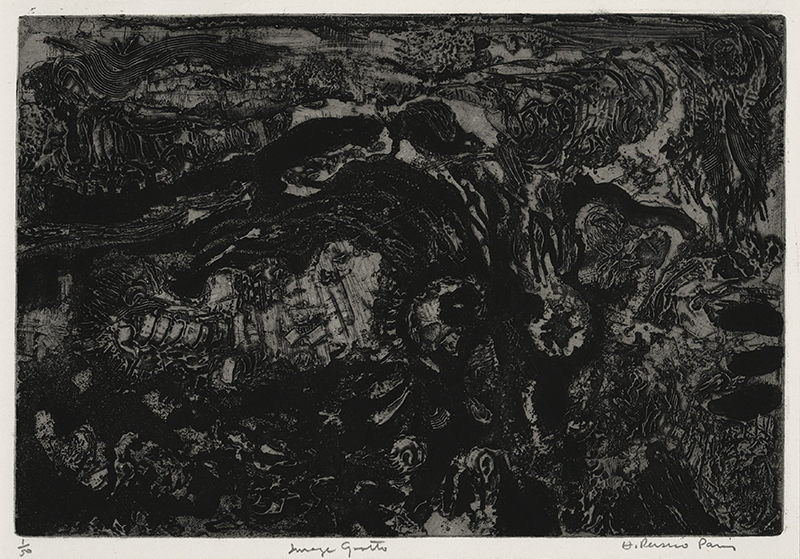
19th, 20th & 21st Century Fine Prints
707-546-7352 · fax 707-546-7924 · web: www.annexgalleries.com · email: artannex@aol.com
Image Grotto by Harold Persico Paris

Image Grotto
Harold Persico Paris
Image Grotto
Harold Persico Paris
1925 - 1979 (biography)Done with a Plexiglas (lucite) matrix the artist used engraving tools, etching, solvents, and collaged elements (collagraphy). The imge is Abstract Expressionist and has a somewhat figurative base - a powerful composition, drawn using controlled energy with interjections of gestural drips and automatic lines.
A grotto is defined as "a natural or artificial cave used by humans in both modern times and antiquity, and historically or prehistorically. Naturally occurring grottoes are often small caves near water that are usually flooded or often flooded at high tide." Paris's grotto is alive with organic life forms - "images" that merge together as past and possibilities.
Harold Persico Paris was born on Long Island, New York on August 6, 1925. Encouraged from an early age to pursue his artistic interests, as a youth he worked behind the scenes at the Yiddish theater where his father was an actor, helping to create sets and costumes and apply the makeup which transformed the actors. This early dramatic influence remained with the artist, showing up later in the personal drama, tension, and inventiveness of his fine art.
Paris studied in America and Europe but considered himself an outsider, eschewing the latest art centers and movements. He studied briefly at Stanley William Hayter's Atelier 17 and the Creative Lithographic Workshop in New York. Awarded the Louis Comfort Tiffany Fellowship, the John Simon Guggenheim Fellowship, and the Fulbright Fellowship, he applied these to realizing goals in graphics, painting and casting. He lived in Madrid while guest instructing at the Academia de San Fernando and in Munich while studying casting at the Akademie der Bildenden Kunst.
As a correspondent for Stars and Stripes during World War II, Paris witnessed the death camps at Buchenwald. Profoundly affected, he began his Buchenwald series of graphics in 1945, and his personal torment woud underlie his imagery for the majority of his career. There are Semitic references in his imagery and titles but the iconography is personal, unique, and defies categorization.
Paris moved to California between 1960-'61. At the age of thirty-five, he became Assistant Professor of Art at University of California, Berkeley and was promoted to full Professor in 1972. During these seminal years he continued to explore the new medium of plastic and expand upon the use of ceramics by developing means to strengthen and support ceramic walls and rooms. He co-founded a bronze foundry in Berkeley and developed techniques of welding and casting thought impossible by others.

